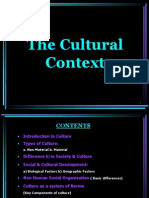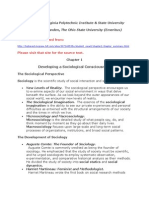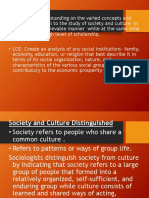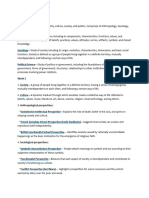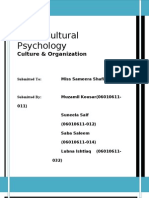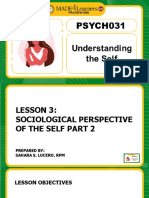0 ratings0% found this document useful (0 votes)
11 viewsSocy 101 Exam Defination
Socy 101 Exam Defination
Uploaded by
khenana06Exam definition
Copyright:
© All Rights Reserved
Available Formats
Download as DOCX, PDF, TXT or read online from Scribd
Socy 101 Exam Defination
Socy 101 Exam Defination
Uploaded by
khenana060 ratings0% found this document useful (0 votes)
11 views7 pagesExam definition
Copyright
© © All Rights Reserved
Available Formats
DOCX, PDF, TXT or read online from Scribd
Share this document
Did you find this document useful?
Is this content inappropriate?
Exam definition
Copyright:
© All Rights Reserved
Available Formats
Download as DOCX, PDF, TXT or read online from Scribd
Download as docx, pdf, or txt
0 ratings0% found this document useful (0 votes)
11 views7 pagesSocy 101 Exam Defination
Socy 101 Exam Defination
Uploaded by
khenana06Exam definition
Copyright:
© All Rights Reserved
Available Formats
Download as DOCX, PDF, TXT or read online from Scribd
Download as docx, pdf, or txt
You are on page 1of 7
DIFFINATIONS AND ESSAY.
CHAPTER 3: Introduction to Sociological Method
Positivism: It is the legal system that bases knowledge on direct, systematic observation.
Humanism: Sees that studying the human world is very different from studying biological,
physical, or material world.
4 Major Research Tools
1.Survey: This is the research method that is used to collect data from predefined groups of
respondents to gain information and insight on topic of interest.
2.Experiment: This is the research method where the researcher manipulates one or more
variables to observe effects on another variable.
3.Questionnaires and Interview: Questionnaires is the set of questions designed to gather
information from respondents. Interview involves the direct, face 2 face, telephone, and
video conversation between researcher and respondent.
4.Participant Observation: This is a qualitative research method where the researcher
immerses themselves in environment or community being studied to observe behaviors,
interaction, and social practices.
DEFINATIONS.
>. Variable: It is an empirical property that takes two or more values.
>. Independent Variable: It is the explanatory variable; it is presumed cause of effects on the
values of independent variable.
>. Dependent Variable: it is the expected outcome of independent variable.
>. Hypothesis: It is the quizzing answer toward the problem, it is like a statement of expected
results.
>. Quantitative research: It is based on the measurements of quality or amount or deals with
numerical form.
>. Qualitative research: Is concerned with qualitative phenomena relating to quality or kind.
>. Epistemology: Is the branch of philosophy concerned with the theory of knowledge.
>. Validity: Refers to the extent to which a concept, conclusion, or measurement is well-
founded and accurately reflects the real world.
>. Measurement: Is the process of obtaining a quantitative description of the characteristics.
Short Questions.
>. Limitation of scientific sociology.
>. Scientific sociology, which aims to study social phenomena through systematic, empirical
investigation, has several limitations. Here are some key limitations:
>. Complexity of Social Phenomena: Social behavior and structures are often complex and
influenced by numerous interrelated factors, making it challenging to isolate variables.
>. Measurement Challenges: Social concepts like power, culture, and identity are difficult to
quantify.
>. Interpretive Limitations: Scientific sociology focuses on empirical data and often neglects
the subjective meanings and experiences of individuals.
>. Reductionism: The scientific approach often involves breaking down complex social
phenomena into simpler components for analysis.
CHAPTER 4: Societies.
DEFINATIONS.
>. Sociocultural Evolution: Is the process of change that results from societies getting new
information, particularly technology.
>. Indigenous People: People with ties to the land, water, and wildlife of the ancestral
domain.
>. Hunting and Gathering societies: Are people that don’t have permanent settlement who are
domain they move constantly to find food and water.
>. Horticulture: Is technology based on using hand tools to cultivate plants.
>. Pastoralism: It is based on technology to domesticate wild animals.
>. Agriculture: It is the technology of large-scale farming using ploughs harnessed to animals,
and powerful source of energy.
>. Industrialism: It is the technology that powers advanced machinery with advanced source
of energy.
>. Post-industrialism: It refers to computer linked technology that supports an information-
based economy.
>. Social Conflict: It is the struggle between segments of society over valued resources.
>. Alienation: It refers to a condition in which individuals feel isolated or disconnected from
various aspects of their social environment.
>. Capitalism: Is an economic system whereby raw materials and the means of production
and distribution of goods and services is privately owned.
SHORT QUESTIONS: KARL MAX, MAX WEBER, EMILE DURKHEIM.
1.Karl Max: Conflict theory
>. The premise of conflict theory, particularly as developed by Karl Marx, is that society is
fundamentally shaped by conflicts arising from inequalities in power, resources, and social
status. Conflict theory posits that these conflicts drive social change and are inherent in all
societies due to the economic and social structures that create and perpetuate disparities.
2.Emile Durkheim: Structural functionalist theory
>. The main premise of structural functionalist theory, as developed by Émile Durkheim, is
that society is a complex system composed of various parts, each with a specific function that
contributes to the stability and equilibrium of the whole. Structural functionalism views
society as analogous to a living organism, where each part (institution) works together to
maintain the health and functionality of the entire system.
3. Max Weber: Social action theory
>. The main premise of social action theory, as developed by Max Weber, is that social
behavior and structures can only be understood by examining the subjective meanings and
intentions that individuals attach to their actions. Weber's approach emphasizes the
importance of understanding the motivations and contexts that drive individual actions, rather
than merely focusing on external, observable behaviors.
(4). How did each of these theorists see society, how was society changing?
>. Changes in Society:
. Marx: Marx perceived society as undergoing a transition from capitalism to socialism and
communism, driven by class struggle and contradictions within capitalism.
. Durkheim: Durkheim observed changes in social integration and solidarity, with societies
transitioning from mechanical to organic solidarity due to industrialization and urbanization.
. Weber: Weber analyzed the rationalization and bureaucratization of modern societies, where
traditional forms of authority are replaced by rational-legal structures.
CHAPTER 5: CULTURE
>. Culture: Is the value, beliefs, behavior and material object that together forms a people
way of life.
>. Civilizations: It is the complex human society characterized by the development of cultural
and technological advancements, and established institutions.
>. Material Culture: It is referred to an objects or belongings of group of people.
>. Non-material Culture: It consist of ideas, attitudes, and beliefs of a society.
>. Sub-culture: It is a smaller cultural group within the larger culture.
>. Counterculture: It is a group who’s values and norms deviate form or are equal with those
of dominant culture.
>. Symbols: Such as gesture, signs, objects, and words that helps people understand the
world.
>. Language: It is the symbolic system through which people communicate and which culture
is transmitted.
>. Values: These are culture’s standards for judging what is good in the society.
>. Beliefs: These are the tenets or convictions that people hold to be true.
>. Norms: It defines how to behave or react in an acceptable manner in the society.
>. Mores: These are norms that embody the moral views and principles of the group.
>. Folkway: is defined as socially accepted behavior, that governs everyday practices within a
culture.
ESSAY: CULTURE (Five major components of culture: symbols, language, values,
norms, and material culture.)
Culture is a comprehensive concept that encompasses the ways of life shared by a group of
people. It includes their practices, beliefs, customs, and artifacts. The major components of
culture—symbols, language, values, norms, and material culture—are integral to
understanding how cultures function and evolve.
Symbols
Symbols are objects, gestures, sounds, or images that represent something other than
themselves. They carry meanings recognized by people who share the same culture. Symbols
are crucial for communication and the transmission of cultural values. For instance, the flag
of a nation, a wedding ring, or religious icons are all symbols that convey deep significance
and invoke collective understanding and emotion. Symbols can unify groups, create a sense
of identity, and differentiate one culture from another.
Language
Language is a system of symbols that allows people to communicate with one another. It is
perhaps the most important component of culture, as it facilitates the transmission of
knowledge, ideas, values, and customs. Language shapes how individuals perceive and
interact with the world, influencing their thoughts and behaviors. Each culture has its own
languages or dialects that reflect its history, environment, and social structures. Language not
only conveys information but also carries emotional and social cues, playing a critical role in
social integration and cohesion.
Values
Values are deeply held beliefs about what is good, desirable, and proper—or bad, undesirable,
and improper. They serve as the criteria for evaluating the actions of individuals and the
functioning of social institutions. Values guide behavior and form the basis for norms and
laws within a society. For example, in many cultures, values such as freedom, equality, and
justice are paramount and shape the social and legal systems. Values can vary widely between
cultures, leading to different social norms and practices.
Norms
Norms are the rules and expectations by which a society guides the behavior of its members.
They are derived from values and manifest in two forms: mores and folkways. Mores are
norms that are deemed highly necessary to the welfare of a society, often upheld by laws and
severe sanctions. For instance, norms against theft and murder are considered mores.
Folkways, on the other hand, are norms for routine or casual interaction. They dictate
everyday behavior, such as dress codes, table manners, and greetings, and are generally less
strictly enforced. Adherence to norms ensures social order and predictability, while violations
may result in social sanctions ranging from mild disapproval to severe punishment.
Material Culture
Material culture refers to the physical objects, resources, and spaces that people use to define
their culture. These include technology, buildings, clothing, tools, and artwork—everything
that humans create and use. Material culture reflects the values, beliefs, and norms of a
society and evolves as technology and societal needs change. For example, smartphones and
the internet are significant components of contemporary material culture, shaping
communication, information access, and social interactions. The study of material culture
provides insights into the daily lives, technological advancements, and economic conditions
of a culture.
Conclusion
Understanding the five major components of culture—symbols, language, values, norms, and
material culture—provides a comprehensive framework for analyzing and appreciating the
complexities of human societies. These components are interrelated and collectively
contribute to the distinctive identity and functionality of each culture. By examining these
elements, sociologists and anthropologists can gain a deeper understanding of how cultures
develop, maintain social order, and adapt to changes over time.
CHAPTER 7: The Construction of Everyday Life.
>. Primary socialization agents, Family, and Parents
. The family is the first and most influential socializing agent in a person's life. From birth,
the family environment provides the initial context in which socialization occurs.
. Parents, as primary caregivers, play a central role in the socialization process within the
family unit. Their influence is profound and multifaceted.
>. Secondary socializing agents, School or other Institution?
. Schools are vital institutions in the socialization process, providing structured education and
social interaction outside the family environment. They play several key roles, academic
education, social values and norms, cultural transition, and social skills and interactions.
. Beyond schools, several other institutions contribute to the socialization process, each
playing a unique role in shaping individuals' social experiences and development, peers’
groups, media, workplace, and community organizations.
>. Things that are normally learned during socialization process.
. Human being relies on social experience to learn the nuances of their culture to survive.
. Socialization is also a process which humans learn about the social groups to which they
primarily belong.
. There is no discussion of socialization can ignore the importance of nature and nurture.
>. Sigmund Freud: Human personality made up of 3 parts - Id, Ego, Superego
. Sigmund Freud the founder of psychoanalysis proposed a model of human personality that
is comprised of three interacting parts.
= The Id is the primal, unconscious part of the personality that operates on the pleasure
principle. An Ego is the rational part of the personality that operates on the reality principle.
The Superego is the moral component of the personality, embodying internalized societal and
parental standards of conduct.
>. George Herbert Mead: concept of self
. George Herbert Mead introduced the concept of the self, which he believed emerges from
social interactions and communication with others. According to Mead, the self has two
components: the "I" and the "Me." The “I” It represents individual agency and personal
responses to the social environment. The "Me" is the reflective, socialized aspect of the self,
formed through interactions with others.
. Role-Taking: Mead emphasized the importance of role-taking, where individuals put
themselves in others' positions to understand their perspectives.
>. Stages of Self-Development: Mead outlined stages in the development of the self.
= Preparatory Stage: Young children imitate others without understanding the meanings of
their actions.
= Play Stage: Children begin to take on roles of specific others (e.g., playing "mom" or
"dad") and understand these roles.
= Game Stage: Children learn to consider multiple roles simultaneously and understand the
rules of broader social contexts.
You might also like
- CSS Sociology Notes - PDF Version 1Document32 pagesCSS Sociology Notes - PDF Version 1RabiAngel83% (24)
- The Cultural ContextDocument39 pagesThe Cultural Contextraheel100% (1)
- Culture Exam NotesDocument4 pagesCulture Exam Notesstephenjohn.bonocanNo ratings yet
- Sociology: Perspective, Theory, and MethodDocument25 pagesSociology: Perspective, Theory, and MethodTRISH BOCANo ratings yet
- The Sociological PerspectiveDocument59 pagesThe Sociological PerspectiveGenna Kachi DicimulacionNo ratings yet
- The Sociological PerspectiveDocument59 pagesThe Sociological PerspectiveAndalib TabassumNo ratings yet
- Society Vs CultureDocument19 pagesSociety Vs CultureJay Mark SantosNo ratings yet
- Midterm ReviewDocument11 pagesMidterm ReviewOmari McDuffey100% (2)
- Sociology Reviewer PDFDocument16 pagesSociology Reviewer PDFCheska Lesaca80% (5)
- UCSP First Quarter ReviewerDocument5 pagesUCSP First Quarter Reviewertaguibebraedenmark100% (1)
- Member of SocietyDocument4 pagesMember of SocietyLeones, Moanah A.No ratings yet
- General Sociology Key TermsDocument2 pagesGeneral Sociology Key Termsgleemoore makieNo ratings yet
- Cso 101 PPT NotesDocument44 pagesCso 101 PPT Notesmuminaramadhan85No ratings yet
- Culture and Socialisation 20231122 003825 0000Document9 pagesCulture and Socialisation 20231122 003825 0000ridhimaupadhyay159No ratings yet
- Culture and Society 4Document20 pagesCulture and Society 4Faryal ArifNo ratings yet
- Culture - 1 (1) ADocument10 pagesCulture - 1 (1) Aaiza khanNo ratings yet
- Study Guide Midterm Terms To Know SOCDocument7 pagesStudy Guide Midterm Terms To Know SOCMichelle WhiteNo ratings yet
- Hand Out Lesson 4Document4 pagesHand Out Lesson 4christian jamisolaNo ratings yet
- Sociology Class 20 November 21Document5 pagesSociology Class 20 November 21vaw825ugaNo ratings yet
- Written Report Socio-Cultural AnthropologyDocument8 pagesWritten Report Socio-Cultural AnthropologyJo-Nathaniel G. ValbuenaNo ratings yet
- Understanding Culture, Society and PoliticsDocument30 pagesUnderstanding Culture, Society and PoliticsFfrekgtreh FygkohkNo ratings yet
- UCSP - LESSON 1Document7 pagesUCSP - LESSON 1Vanessa Tamayo, Ph. DNo ratings yet
- Social Dimensions OF EducationDocument37 pagesSocial Dimensions OF Educationjorolan.annabelleNo ratings yet
- Ucsp 1st Quarter Without Quizzes (1)Document8 pagesUcsp 1st Quarter Without Quizzes (1)leojheyechavezNo ratings yet
- DISS ReviewerDocument8 pagesDISS Reviewerfaithmargarett17.7No ratings yet
- 208Document10 pages208kanij3497No ratings yet
- Culture and SocializationDocument9 pagesCulture and SocializationmiriamNo ratings yet
- CultureDocument2 pagesCulturekuruchiNo ratings yet
- Culture & OrganizationDocument26 pagesCulture & OrganizationMuzamilNo ratings yet
- Becoming A Member of SocietyDocument25 pagesBecoming A Member of SocietyKate KatNo ratings yet
- Q & A ABOUT SOCIOLOGYDocument4 pagesQ & A ABOUT SOCIOLOGYdushimimanaseverine95No ratings yet
- Ucsp Three Social ParadigmsDocument19 pagesUcsp Three Social ParadigmshfjnbbwmyfNo ratings yet
- Soc MidDocument76 pagesSoc MidJohnNo ratings yet
- Becoming A Member of SocietyDocument27 pagesBecoming A Member of SocietyJikubNo ratings yet
- Ucsp Lesson 2Document7 pagesUcsp Lesson 2elie lucidoNo ratings yet
- Indigenous Knowledge, Anthropology.Document34 pagesIndigenous Knowledge, Anthropology.Cumar MaxamuudNo ratings yet
- UCSPDocument6 pagesUCSPManuelluis MaltoNo ratings yet
- Culture: Definition and Elements of CultureDocument10 pagesCulture: Definition and Elements of CultureDianne AcquiatNo ratings yet
- Chapter TwoDocument15 pagesChapter TwomymommywowNo ratings yet
- ANTH 1012 Note Unit 3 SummaryDocument8 pagesANTH 1012 Note Unit 3 SummaryakalewoldkaleabNo ratings yet
- Chap 3 - CultureDocument5 pagesChap 3 - CultureMD TOWHIDUL ISLAMNo ratings yet
- UCSP Member of SocietyDocument42 pagesUCSP Member of SocietyPonpon AbancoNo ratings yet
- Social Science AML NMAT ReviewerDocument11 pagesSocial Science AML NMAT ReviewerJoyjaneLacsonBorres100% (2)
- MODULE 1: Culture, Society and Politics: The Faces And: Perspectives of Anthropology, Sociology and Political ScienceDocument20 pagesMODULE 1: Culture, Society and Politics: The Faces And: Perspectives of Anthropology, Sociology and Political ScienceShame BalognapoNo ratings yet
- Culture AssignmentDocument2 pagesCulture AssignmentAnam AnamNo ratings yet
- The Cybernetic, Sociopsychological Critical, and Rhetorical TraditionDocument20 pagesThe Cybernetic, Sociopsychological Critical, and Rhetorical TraditionMahesh NairNo ratings yet
- Chapter 3 Summarize UCSPDocument7 pagesChapter 3 Summarize UCSPCris Labiaga Aranas0% (1)
- Sociology NotesDocument11 pagesSociology Notesreachermac01No ratings yet
- CultureDocument5 pagesCultureSintaro M. TakamiaNo ratings yet
- Understanding The Concept of Culture J Society and PoliticsDocument28 pagesUnderstanding The Concept of Culture J Society and PoliticsEleazar Frias BarroNo ratings yet
- UCSP Week 1 9 by TelDocument12 pagesUCSP Week 1 9 by TelMaria Ellanie Jane BayonaNo ratings yet
- Anthropological and Sociological Perspectives On Culture and Society?Document9 pagesAnthropological and Sociological Perspectives On Culture and Society?Sharmaine Paragas FaustinoNo ratings yet
- Unit 3-Anth 1012,Document53 pagesUnit 3-Anth 1012,tadelenatnael57No ratings yet
- Sociology Chapter One: The Sociological PerspectiveDocument4 pagesSociology Chapter One: The Sociological Perspectivejmarte01No ratings yet
- Understandingculturesocietyandpolitics Cultureandsociety 180803114815Document44 pagesUnderstandingculturesocietyandpolitics Cultureandsociety 180803114815Lamberto Pilatan Jr.No ratings yet
- sociology POPALDocument6 pagessociology POPALahmadpopalpopalzaiNo ratings yet
- Geelect 3 SummaryDocument3 pagesGeelect 3 SummaryMUYCO CHERRYNo ratings yet
- Soci 1000 Test ReviewDocument4 pagesSoci 1000 Test ReviewjeffNo ratings yet
- Chapter 3Document4 pagesChapter 3Jimuel AdrianoNo ratings yet
- Lesson 2 EthicsDocument7 pagesLesson 2 Ethicsnot funny didn't laughNo ratings yet
- POWERPOINT-UCSP Q1 Topic3-NewDocument21 pagesPOWERPOINT-UCSP Q1 Topic3-Newgabrielenrico321No ratings yet
- LECTURE 2 Culture and CommunicationDocument8 pagesLECTURE 2 Culture and Communicationacademic11.thamesukNo ratings yet
- Gen Soc Prelim ModuleDocument13 pagesGen Soc Prelim ModuleMa. Oliva Diana CastroNo ratings yet
- CESCDocument3 pagesCESCAdvyn Ramos EscobillaNo ratings yet
- Wk3 Significant of Studying Culture Society and PoliticsDocument39 pagesWk3 Significant of Studying Culture Society and PoliticsCherry AduanNo ratings yet
- Ibm Chapter TwoDocument78 pagesIbm Chapter TwomistereNo ratings yet
- Module 3Document15 pagesModule 3Melissa PummaNo ratings yet
- Society and Culture With Family PlanningDocument57 pagesSociety and Culture With Family PlanningKaren FumarNo ratings yet
- Community Engagement, Solidarity, and CitizenshipDocument7 pagesCommunity Engagement, Solidarity, and CitizenshipErika GeneralNo ratings yet
- 1.introduction To Cultural StudiesDocument34 pages1.introduction To Cultural StudiesSophia PapaNo ratings yet
- Chapter 4 Culture and SocialisationDocument8 pagesChapter 4 Culture and SocialisationRubina AhmadNo ratings yet
- Ucsp - Module 1 2Document8 pagesUcsp - Module 1 2angeladmana09No ratings yet
- Norms, Values, Folkways and MoresDocument17 pagesNorms, Values, Folkways and Moresramreceives86% (7)
- Chapter 1 Culture and Arts Education in Plural SocietyDocument15 pagesChapter 1 Culture and Arts Education in Plural Societychristianaivanvaldez.bcaedNo ratings yet
- In SociologyDocument2 pagesIn SociologyTalha KhanNo ratings yet
- LET Review Material 19Document6 pagesLET Review Material 19Mark Dela Cruz MoralesNo ratings yet
- Social ControlDocument11 pagesSocial ControlEvanshisha RiphaiNo ratings yet
- Culture LagDocument27 pagesCulture LagpanhwarsehwanNo ratings yet
- UCSP WEEK 2 Analyze The Concept Aspects and Changes in of Culture and SocietyDocument8 pagesUCSP WEEK 2 Analyze The Concept Aspects and Changes in of Culture and SocietyPaula DT PelitoNo ratings yet
- Unit ThreeDocument9 pagesUnit ThreesamuelkintuskNo ratings yet
- Sumner and SavignyDocument30 pagesSumner and SavignySteven Mathew100% (1)
- Literature ReviewerDocument5 pagesLiterature ReviewerZia GuerreroNo ratings yet
- Questionnaire 1Document2 pagesQuestionnaire 1Sherra Mae BagoodNo ratings yet
- First Quarter Grade 11 UCSPDocument6 pagesFirst Quarter Grade 11 UCSPGary VargasNo ratings yet
- Uts Module 1Document39 pagesUts Module 1Lexine Mandar SunNo ratings yet
- Phil Pop Culture - Reading 3 - More About CultureDocument5 pagesPhil Pop Culture - Reading 3 - More About CultureNurse NotesNo ratings yet
- Lesson 3 Sociological Perspective of The Self Part 2Document18 pagesLesson 3 Sociological Perspective of The Self Part 2Chaz grant borromeoNo ratings yet
- Norms and It's Types in Sociology (Lec 13) .Document12 pagesNorms and It's Types in Sociology (Lec 13) .FARHAN MEERNo ratings yet


